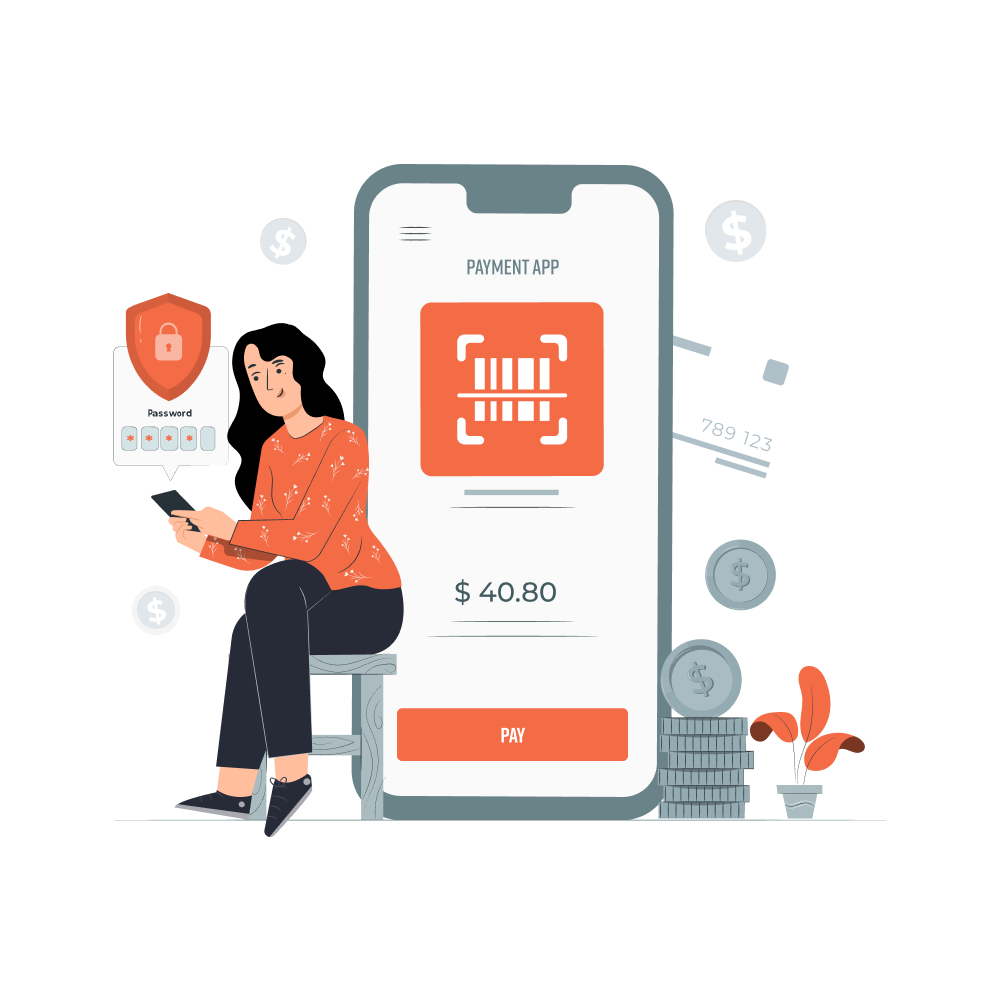E-wallet apps have become increasingly popular in recent years, and for a good reason. They provide a convenient and secure way to make digital payments using your mobile device without the need for cash or cards. Building an E-wallet app is a profitable opportunity for businesses, with the global mobile payment market expected to reach $4.5 trillion by 2023. However, creating a secure and user-friendly payment app is challenging. This guide will take you through the essential steps in E-wallet app development, from planning and design to implementation and launch.
Guide to E-Wallet App Development
Planning and Design
The first step in E-wallet app development is planning and design. This involves market research and analysis, identifying the target audience, defining app features and functionalities, creating wireframes and prototypes, and designing the user interface and user experience.
Market Research and Analysis:
Before developing an E-wallet app, it’s important to research the market and analyze the competition. This will help you identify gaps in the market and potential challenges and opportunities. Start by researching the target audience and their needs. Identify their pain points and find ways to solve them through your app. Analyze the competition and find ways to differentiate your app from theirs.
Identifying the Target Audience:
Once you’ve conducted market research and analyzed the competition, you can identify your target audience. Consider factors such as age, gender, location, income, and interests. This will help you design an app that meets their needs and provides a seamless user experience.
Also Read : Money Transfer App Development: Cost & Key Features
Defining App Features and Functionalities:
Based on your research and target audience analysis, you can define the features and functionalities of your E-wallet app. Some essential features to consider include the following:
- Secure login and authentication
- Account management and transactions
- Payment methods and integrations with third-party services
- User profile and preferences
- Push notifications and alerts
Creating Wireframes and Prototypes:
Once you’ve defined the features and functionalities of your E-wallet app, you can create wireframes and prototypes. This will help you visualize the app’s user interface and user experience. It’s important to keep the design simple and intuitive, so users can easily navigate the app and complete transactions.
Designing User Interface and User Experience:
Finally, you can design the user interface and user experience of your E-wallet app. This involves creating a visually appealing design that’s easy to use and navigate. Consider factors such as color scheme, typography, and iconography. Use consistent design language throughout the app to provide a seamless user experience.
Development and Implementation
The next step in E-wallet app development is development and implementation. This involves choosing the right technology stack, building and testing the app, integrating with third-party services and APIs, implementing security protocols, and finalizing the app for launch.
Choosing the Right Technology Stack:
When building an E-wallet app, it’s important to choose the right technology stack. This involves selecting well-suited programming languages, frameworks, and libraries for your app’s features and functionalities. Consider factors such as scalability, security, and ease of development.
Building and Testing the App:
Once you’ve chosen the technology stack, you can start building the app. This involves writing code, testing the app, and fixing bugs and errors. It’s important to conduct thorough testing to ensure the app is working as intended and provides a seamless user experience.
Integrating with Third-Party Services and APIs:
You can integrate with third-party services and APIs to provide additional functionality to your E-wallet app. This can include payment gateways, fraud detection services, and social media platforms. It’s important to choose reputable and secure third-party services to ensure the security of user data.
Implementing Security Protocols:
One of the most important aspects of E-wallet app development is implementing security protocols. This involves ensuring the security of user data, protecting against fraud and cyber attacks, and complying with relevant regulations. Some essential security measures to consider include:
- Secure login and authentication using two-factor authentication or biometric authentication
- Encryption of sensitive data such as passwords and transaction details
- Regular security updates and patches
- Compliance with industry regulations such as PCI DSS and GDPR
Finalizing the App for Launch:
Once the app has been developed and tested, it’s time to finalize it for launch. This involves preparing marketing materials, creating an app store listing, and submitting the app to the app store for review. It’s important to follow app store guidelines and policies to ensure the app is approved for launch.
Findout More : Crypto Exchange App Development: An Ultimate Guide for 2023
Launch and Maintenance
When it comes to E-wallet app development, security, and compliance are critical considerations that can make or break your app’s success. Here are some best practices to follow to ensure your app is secure and compliant:
Use Encryption and Secure Authentication:
Encryption is a process of converting plain text data into a code to prevent unauthorized access. E-wallet apps must implement encryption to protect sensitive user data, such as passwords, personal information, and transaction details. It’s also essential to use secure authentication methods such as two-factor authentication or biometric authentication to ensure that only authorized users can access the app.
Comply with Industry Regulations:
E-wallet apps must comply with industry regulations such as the Payment Card Industry Data Security Standard (PCI DSS) and the General Data Protection Regulation (GDPR). These regulations are designed to protect user data and ensure the security of online transactions. Complying with these regulations can build trust with your users and avoid legal complications.
Regularly Update and Patch the App:
Regular updates and patches are critical to ensuring the security of your E-wallet app. Cyber threats are constantly evolving, and new vulnerabilities are discovered regularly. By regularly updating your app, you can stay ahead of cybercriminals and protect your users’ data.
Test the App Thoroughly:
Thorough testing is crucial to ensure that your E-wallet app works as intended and provides a seamless user experience. You should conduct testing on all platforms and devices to ensure compatibility and performance. Additionally, you should perform security testing to identify vulnerabilities and weaknesses in the app’s security measures.
Monitor User Activity:
Monitoring user activity can help you identify and prevent fraudulent activities, such as unauthorized transactions or attempts to breach the app’s security. You can use fraud detection tools and machine learning algorithms to detect suspicious activities and prevent fraud before it occurs.
Deep Dive : Top 10 Tips to Reduce Your App Development Costs
Tips for Building a Secure and User-Friendly Payment App
Building a secure, user-friendly payment app requires careful planning, design, and implementation. Here are some tips to keep in mind when developing an E-wallet app:
- Conduct thorough market research and analysis to identify user needs and gaps in the market
- Design a simple and intuitive user interface that’s easy to navigate
- Implement security protocols to protect user data and comply with industry regulations
- Test the app thoroughly to ensure it’s working as intended and provides a seamless user experience
- Continuously update and improve the app based on user feedback and changing market trend.
Dig Deeper : Custom Healthcare App Development in 2023 [The Ultimate Guide]
Conclusion
Building a secure and user-friendly payment app is a complex process that requires careful planning, design, and implementation. By following the steps outlined in this guide, you can create an E-wallet app that meets the needs of your target audience and provides a seamless user experience. Remember to prioritize security and compliance with industry regulations to protect user data and maintain user trust. With the global mobile payment market expected to continue to grow, building an E-wallet app is a lucrative opportunity for businesses looking to expand their digital offerings.
How can NeoITO help in building this service?
In addition to following the steps outlined in this guide, partnering with a software development company like NeoITO can help you build a custom E-wallet app that meets your unique business needs. Our team of experienced developers can guide you through the app development process, from ideation to launch and beyond. We also specialize in creating AI chatbots that can enhance your app’s user experience and provide personalized support to your users.
So why wait? Start building your E-wallet app today with NeoITO’s expert services. Contact us to learn more and get started on your journey to creating a secure and user-friendly payment app.
FAQs
What features should I include in my E-Wallet app to make it user-friendly?
Some key features that can make your E-Wallet app user-friendly are a simple and intuitive user interface, easy registration and login process, quick and easy payment options, and the ability to view transaction history and account balance.
How do I ensure the security of user data in my E-Wallet app?
To ensure the security of user data in your E-Wallet app, you should use advanced security measures such as encryption, two-factor authentication, and biometric authentication. You should also comply with industry regulations such as PCI DSS and GDPR.
What are the key compliance regulations I need to consider when developing an E-Wallet app?
Some key compliance regulations you need to consider when developing an E-Wallet app are PCI DSS, GDPR, and AML/KYC regulations. These regulations are designed to protect user data and prevent financial fraud.
How can I effectively promote my E-Wallet app before launch?
To effectively promote your E-Wallet app before launch, you can use a combination of social media marketing, influencer marketing, content marketing, and paid advertising. You can also leverage your existing customer base and offer incentives for early adopters.
How often should I update my E-Wallet app after launch?
You should update your E-Wallet app regularly to fix any bugs, improve user experience, and ensure compliance with industry regulations. The frequency of updates may depend on the complexity of your app and the feedback from your users.




